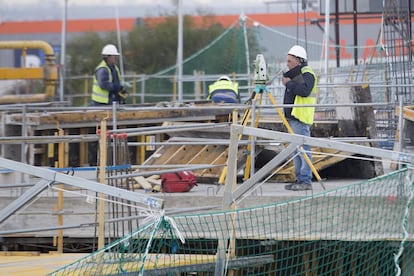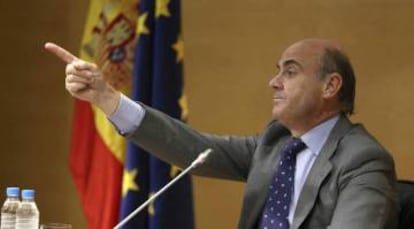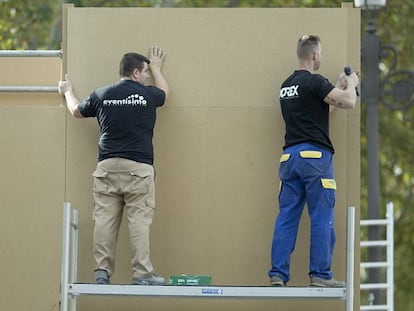Spanish economy outperforms expectations to grow 3.2% in 2016
Output has recovered 80% of what it lost during economic crisis but GDP make-up has changed since 2008
In 2016, the Spanish economy outperformed all the forecasts made by expert organizations, which had been expecting a slowdown in the early part of the year. Instead, the economy grew 3.2%, the same pace as the previous year, according to preliminary figures released on Monday by the National Statistics Institute (INE).

From September to December, GDP growth was 0.7%, an identical figure to the previous quarter but lower than the previous six quarters. The data suggests a mild slowdown during the second half of the year.
The new numbers also show that the Spanish economy has grown for the third year in a row. In that time, it has recovered around 80% of what it lost during the crisis, in real terms. Factoring in the effects of inflation, Spanish GDP has gained back practically 95% of what it lost.
In 2016, tourism receipts also shattered all previous records
“Looking at these numbers, we can assume that this year we will go back to pre-crisis activity levels,” says José Domingo Roselló, an analyst at the Madrid-based economic research institute Flores de Lemus.
The data appear to confirm earlier statements by Spanish Economy Minister Luis de Guindos that GDP will go back to 2008 levels by the middle of this year.
But there are differences in the make-up of today’s GDP compared with nearly a decade ago. For one thing, there are many more exports now. There is less employment: there are currently 18.5 million people in employment, 2.25 million fewer than the historical high, according to the workforce survey, the Encuesta de Población Activa (EPA).
There is also less investment than back when construction was the primary engine of growth. As for salaries, only half of the wage bill of 2008 has been restored.

The GDP recovery is thus based mostly on the export of goods and services, which have shot up from around 25% to 33% of GDP on the back of a competitive devaluation, a search for new markets and a recent recovery of the European economy.
Compared with 2009, export of goods grew by around €90 billion, hitting historical highs despite a global slowdown in trade. By comparison, exports represent 12% of GDP in the United States, 18% in Japan, 22% in China and 45% in Germany.
In 2016, tourism receipts also shattered all previous records, while the sale of non-tourism related services grew even more.
Extraordinary year
Despite the forecasts, there was no slowdown last year thanks to lower oil prices, exceptional tourism figures driven by perceptions of risk in other popular destinations, and by a particularly weak euro to the dollar. And European Central Bank policy left interest rates at the lowest levels in memory, reducing the financial load of variable-rate mortgages and making it easier for borrowers to shake off debt.
Meanwhile, rather than shaving off €20 billion from the public deficit as per Brussels’ instructions, Spanish government agencies actually increased their spending slightly, while reducing taxes to the tune of €5 billion. This has allowed the economy to grow much more than expected.
Job creation is also on the rise, even if they are precarious jobs. Low salaries nevertheless encourage greater consumer spending than a situation where people are earning nothing.
The export of goods and services has shot up from around 25% to 33% of GDP on the back of a competitive devaluation
And preliminary figures for 2017 show that economic output is doubling and even tripling growth figures in most other EU member states. However, this is not expected to keep up.
“Most forecasts are talking about a slowdown to somewhere around 2.5% due to more adverse external conditions, to which other changing factors must be added such as the behavior of inflation, which could affect competitiveness, or financing conditions,” says José Ramón Díez Guijarro, chief economist of Bankia’s analysis services.
English version by Susana Urra.
Tu suscripción se está usando en otro dispositivo
¿Quieres añadir otro usuario a tu suscripción?
Si continúas leyendo en este dispositivo, no se podrá leer en el otro.
FlechaTu suscripción se está usando en otro dispositivo y solo puedes acceder a EL PAÍS desde un dispositivo a la vez.
Si quieres compartir tu cuenta, cambia tu suscripción a la modalidad Premium, así podrás añadir otro usuario. Cada uno accederá con su propia cuenta de email, lo que os permitirá personalizar vuestra experiencia en EL PAÍS.
¿Tienes una suscripción de empresa? Accede aquí para contratar más cuentas.
En el caso de no saber quién está usando tu cuenta, te recomendamos cambiar tu contraseña aquí.
Si decides continuar compartiendo tu cuenta, este mensaje se mostrará en tu dispositivo y en el de la otra persona que está usando tu cuenta de forma indefinida, afectando a tu experiencia de lectura. Puedes consultar aquí los términos y condiciones de la suscripción digital.











































